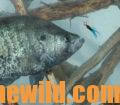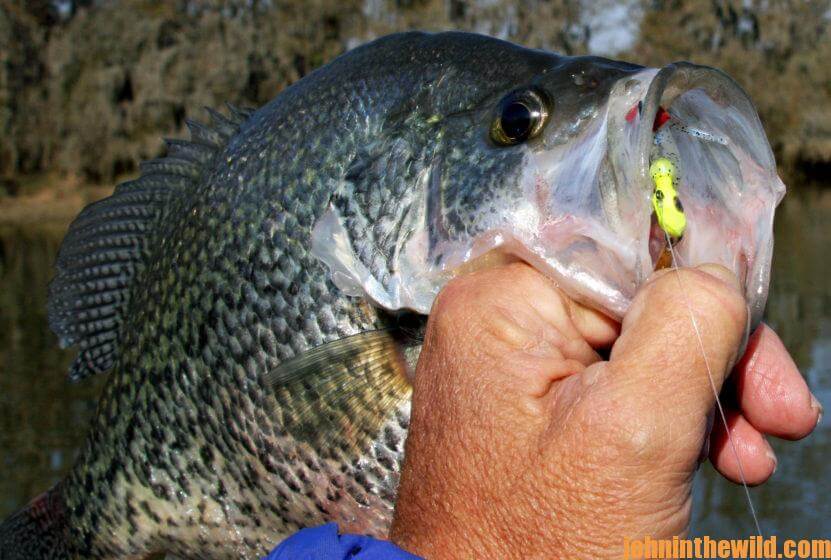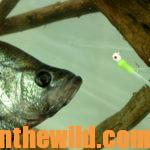Editor’s Note: “If you are hunting the shallow water in April, don’t bet that the big crappie will be there,” the late Dr. Tom Forsythe, a fisheries biologist at Land between the Lakes in Golden Pond, Kentucky, told me some years ago. “As a matter of fact, don’t plan on the big crappie being in shallow water on any particular day that you want to fish during the month of April. I realize this information will surprise people. But it’s the truth.”
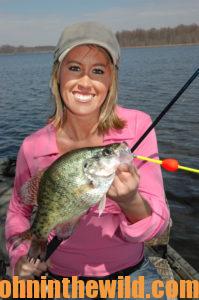 To catch big crappie in April, you have to think like a big crappie. No sportfish or game animal obtains age and size by being as stupid as the younger, smaller of the species are. Crappie that are 1-1/2 – 2 years old will run in to the bank during the first few warm days of April and begin to spawn. They’ll hang around for several days and probably get caught by some inexperienced bank bangers. Although there will be a few big crappie that will run into shore and occasionally get caught, the bigger crappie, the trophy-sized crappie, tend to spawn and stay in deeper water. Oftentimes, the anglers who catch these big crappie consistently and regularly are what I call crappie farmers, crappie navigators, crappie thieves and crappie hermits. Let’s look at each kind of consistent big-crappie catcher.
To catch big crappie in April, you have to think like a big crappie. No sportfish or game animal obtains age and size by being as stupid as the younger, smaller of the species are. Crappie that are 1-1/2 – 2 years old will run in to the bank during the first few warm days of April and begin to spawn. They’ll hang around for several days and probably get caught by some inexperienced bank bangers. Although there will be a few big crappie that will run into shore and occasionally get caught, the bigger crappie, the trophy-sized crappie, tend to spawn and stay in deeper water. Oftentimes, the anglers who catch these big crappie consistently and regularly are what I call crappie farmers, crappie navigators, crappie thieves and crappie hermits. Let’s look at each kind of consistent big-crappie catcher.
* Crappie Farmers – The crappie farmer is just what the word implies. He farms crappie like other farmers farm cotton and corn. He selects his ground very carefully. He’s looking for the kind of ground that won’t just produce crappie, but that will yield the biggest and best crappie all year. He knows that this ground usually will be in 12-14 feet of water right on the edge of a deep creek channel or ledge, or on a deep point that runs up into shallow water, since this type of area will be on the crappie’s migratory route to and from shallow water. Also in choosing his ground, the farmer wants to pick an area that won’t be accessible to crappie rustlers and that no one knows about except him.
Next, the crappie farmer prepares his ground and plants it. After he has located a site (or sites, as the case may be), he will select small cedar trees, river cane, Christmas trees or crepe myrtle limbs that he can sink on the creek channels or points, so that the crappie will have a steady place to hold. He will use his GPS to mark these spots as waypoints, so he doesn’t have to use visible buoys that crappie rustlers can find. A good crappie farmer may have about 30-50 sites where he can take crappie most of the year. And, while everybody else is beating the banks for the average to small-size shallow-water spawners, this wise crappie farmer will be fishing the deep-water brush that he has put out and harvesting April slabs.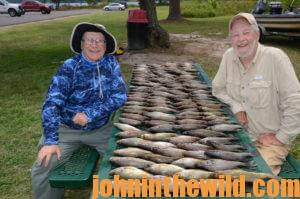
* Crappie Navigators – This crappier is definitely an electronics nut. He can find a dime in 60 feet of water – in a muddy river – on a cloudy day. All he has to do is see bottom structure on his depth finder. Then, he can not only tell you if that bottom structure is rocks, trees and/or bushes, but he also can inform you how big the structure is, how many limbs it has on it, whether or not there are crappie on it, and if there are some fish hiding up under the structure that the depth finder can’t even see. The crappier navigator knows where every creek channel, drop-off, ditch, stump, old home place and old roadbed in the lake is located. Not only that, he understands from which direction the wind is the most favorable to allow him to fish each piece of structure. This fisherman has about 30+ natural spots that always will hold big crappie. During the spring of the year, when the bank bangers have the bushes and the treetops surrounded, the crappie navigator will be running his deep holes and catching deep fish on all the natural structure available in the lake.
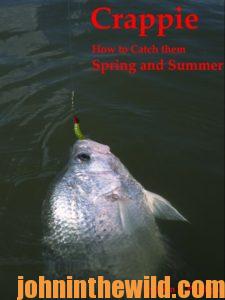 To learn more about crappie fishing, check out John E. Phillips’ book, “Crappie – How to Catch Them Spring and Summer,” available in Kindle and print versions at http://amzn.to/WGaJLT and Click here for the Audible link.
To learn more about crappie fishing, check out John E. Phillips’ book, “Crappie – How to Catch Them Spring and Summer,” available in Kindle and print versions at http://amzn.to/WGaJLT and Click here for the Audible link.
Tomorrow: Learn About Crappie Thieves and Hermits for April Crappie

